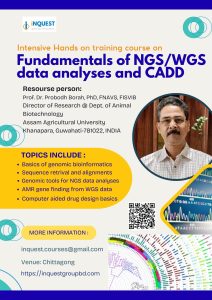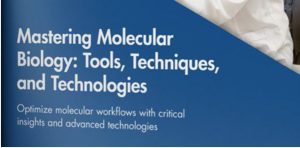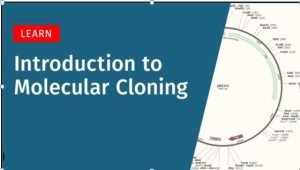Event Details
i017. Molecular Dynamics Simulation with GROMACS for Beginners [12 Modules]
Simulate • Analyze • Discover
Deadline: August 30, 2025
Location: To be disclosed to registered participant
Date: 2nd Sept. 2025
Offered by: iNQUEST
Time: 10:00 AM
Trainers: To be disclosed to registered participant
Fee: 2200/- BDT

Format: 3 days × 4 hours = 12 modules (1 hour each)
Assignments: 2 (end of Day 1 and Day 2)
Fee: 2200 Taka for Students, 4200 Taka for Professionals
Day 1 – Foundations & System Setup (Modules 1–4)
Theme: Basics of MD simulation and initial protein setup
- 1. Basics of Molecular Dynamics simulation (Part 1): What is MD simulation? Theory and principles; Atoms, molecules, and force fields; Applications of MD in structural biology and drug design
- 2. Basics of Molecular Dynamics simulation (Part 2): Workflow of a typical MD simulation; Key steps: preparation → minimization → equilibration → production → analysis; Timescales and limitations of MD
- 3. Getting Started with GROMACS: Why GROMACS? Advantages and applications; Installation (Linux environment overview); File types, commands, and workflow in GROMACS
- 4. Protein Preparation & Force Fields: Downloading protein from RCSB PDB; Cleaning structure (removing waters/ligands if needed); Selecting force fields (CHARMM, AMBER, OPLS); Defining solvent and creating a water box
📌 Assignment 1 (end of Day 1): Prepare protien PDB, apply a force field, and generate a solvated system (gro + top files). Submit input/output files.
—————
Theme: Stabilizing the system
- 5. Adding Ions and Neutralization: Why neutralization is required; Adding ions (Na+, Cl–) in GROMACS
- 6. Energy Minimization: Running energy minimization (mdrun); Checking convergence and energy plots
- 7. Equilibration – NVT (Constant Volume & Temperature): Temperature coupling (Berendsen, V-rescale); Running NVT equilibration; Monitoring temperature stability
- 8. Equilibration – NPT (Constant Pressure & Temperature): Pressure coupling (Parrinello-Rahman); Running NPT equilibration; Monitoring pressure and density stability
📌 Assignment 2 (end of Day 2): Run energy minimization + NVT + NPT on solvated lysozyme. Submit log files + energy/temperature/density plots.
Theme: Running simulation & analyzing trajectories
- 9. Production MD Run: Setting up mdp parameters; Running a short MD simulation (1–2 ns demo)
- 10. Trajectory Handling & Visualization: File conversions (xtc, trr, pdb); Visualization using VMD/PyMOL; Inspecting protein motion
- 11. Basic Analysis of MD Results: RMSD, RMSF; Radius of gyration; Hydrogen bond analysis
- 12. Interpreting & Presenting Results: Generating combined plots; Common pitfalls in MD interpretation
📌 Final Outcome (end of Day 3): Each participant will complete a full MD workflow on a protein: from raw PDB → production MD → basic analysis plots.
Please fill out this form carefully. We’ll select the first 10–15 participants based on your responses and get in touch soon with further details.
For further queries: (Subject: MD Simulation Course)
inquest.courses@gmail.com



